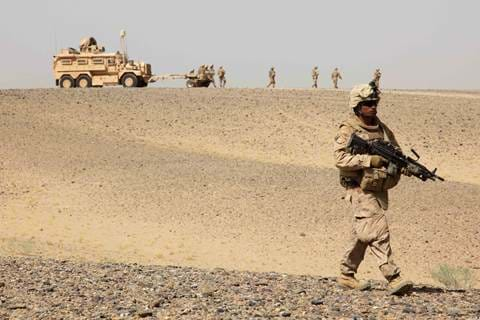Securing Success in Demanding Environments
From the searing heat of the desert to the depths of the oceans: how Chelton secures success in the most demanding of environments

There are few more demanding environments than those faced by public safety and elite military personnel. Whether in the theatre of operations, on search and rescue missions or during emergency services incidents, the settings are uncertain, changeable and dangerous – requiring accurate, reliable and robust equipment to achieve mission success.
A harsh and demanding environment can generally be described as a setting in which survival is difficult or even highly unlikely. From the searing heat of the Sahara Desert at 57°C to the furthest depths of the oceans sinking to over 12,000 feet, conditions differ widely across the world – some more predictable than others. We’re all familiar with the varying impacts of the environment on our bodies, but here we will explore the stresses experienced by avionic equipment.

Temperature Stress
Temperature alone is not a factor that will shut down operations – but it does pose challenges, especially where platforms experience variations in stress due to temperature changes, like in the case of supersonic jets. The constant contraction and expansion can cause stress fractures, leading to platform products being weakened over time. If this regularly happens to your equipment, you’ll find your platform in need of replacements or repairs more frequently.
Chemical Stress
Chemical factors in an operating environment can also disrupt the performance of your avionic equipment. Let’s take salt water, for instance, and its impact on ocean carriers and aircraft based on these vessels. Not only can salt water erode equipment, but it can also be dangerous to electronics – causing the circuits to short. Salt water can also conduct electricity, with the sodium and chlorine acting like charged ions when separated by the water molecules. In addition, rainwater and lightning can affect equipment and could cause it to cease operating entirely.
Mechanical Stress
The physical environment of public safety and military operations may not always be smooth sailing – or, indeed, flying. Depending on the size of the platform, weather conditions and mission type, the environment could be as shaken as James Bond’s martini. The vibration, shock and pressure both you and your aircraft or vehicle experience will inevitably impact your equipment’s integrity. Take g-force, for example; high-speed movement in elevated altitudes and freezing temperatures can feel crushing on your body. But imagine the effect on your equipment in the thick of the action and with little to no protection. Only the strongest survive – and this means equipment that has stress tolerance built into the design and has passed rigorous altitude testing, providing it with its own ‘g-suit’ just like the pilot.
What kind of “stress-busters” will work for your avionic equipment?
What’s the most sure-fire method of reducing the impact and avoiding the effects of temperature, chemical and mechanical stress – aside from never actually taking your equipment “out of the box”? Put your trust in established manufacturers with a rich history of working across multiple platforms and domains, who place great importance in the design and testing process.

At Chelton we’re proud to be on your team. We hold our products to the strictest of standards and implement testing beyond our customers’ requirements, ensuring we don’t just meet, but exceed expectations. Our in-house laboratory capabilities take avionics to the extreme; making sure your equipment can survive blistering humidity of 95% at over 65°C, suffocating tension and compression of up to 30 kN, and stomach-in-your-mouth plunges of over 2,381 feet per second of altitude descent – to name just a few factors. Products are taken through a vast array of tests to secure low mean time between failure (MTBF) rates, something Chelton prides itself on.
We also incorporate specially designed features to protect your equipment, such as a specific protective plastic to shield from temperature changes or anti-erosion paint to withstand all weather conditions without negatively impacting performance. After all, when your equipment doesn’t operate at 100%, your platform won’t either and mission success will be at risk.
How can you secure success in the most demanding of environments? By testing to destruction, as is a matter of course for Chelton. And by relying on our smart thinking, technological excellence and future vision to meet your challenges and redefine your capabilities.
Your quote basket is currently empty
 Please select the type of quote you require for this product:
Please select the type of quote you require for this product: